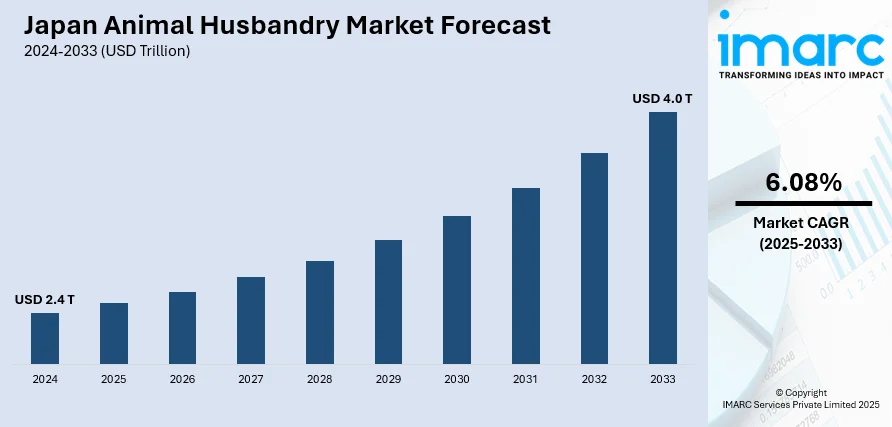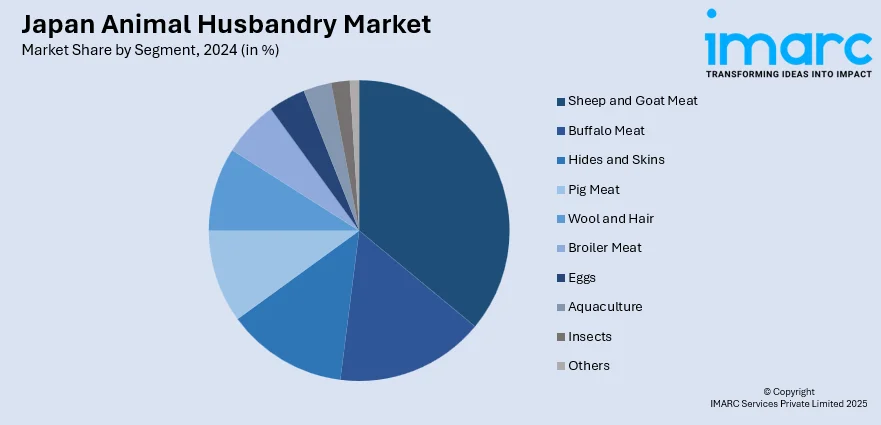
Japan Animal Husbandry Market Size, Share, Trends and Forecast by Segment and Region, 2025-2033
Japan Animal Husbandry Market Overview:
The Japan animal husbandry market size reached USD 2.4 Trillion in 2024. Looking forward, IMARC Group expects the market to reach USD 4.0 Trillion by 2033, exhibiting a growth rate (CAGR) of 6.08% during 2025-2033. The market is advancing through smart farming, emission-reducing feed additives, and waste-to-energy initiatives. Regional innovation, sustainability targets, and rising demand for quality meat and dairy are driving investments in modern livestock practices and technology across key production areas like Hokkaido and Kyushu.
|
Report Attribute
|
Key Statistics
|
|---|---|
|
Base Year
|
2024 |
|
Forecast Years
|
2025-2033
|
|
Historical Years
|
2019-2024
|
| Market Size in 2024 | USD 2.4 Trillion |
| Market Forecast in 2033 | USD 4.0 Trillion |
| Market Growth Rate 2025-2033 | 6.08% |
Japan Animal Husbandry Market Trends:
Focus on Waste-to-Energy Solutions
Japan’s animal husbandry sector is increasingly adopting waste-to-energy practices as part of its broader environmental and sustainability goals. Livestock farming, especially in dairy-intensive areas, generates significant amounts of manure, which has traditionally posed challenges in terms of storage, odor control, and disposal. However, with advancements in biomethane technology and rising energy efficiency standards, animal waste is being viewed as a valuable resource for clean energy production. This shift not only reduces the environmental burden of livestock farming but also contributes to rural energy security and the decarbonization of agriculture. By integrating waste management with energy generation, Japan aims to make its animal husbandry systems more resilient and environmentally sound. In August 2024, Hamanaka Town in Hokkaido partnered with companies like Takanashi Milk Products and Hokkaido Gas to launch a study on biomethane production from dairy manure. The initiative explored the use of manure-derived biomethane to fuel vessels and factories, supporting Japan’s net-zero emissions target. This approach reflected a practical model for circular farming, linking animal production with renewable energy. If scaled, it could transform livestock waste from a liability into a clean energy asset, advancing both farm profitability and sustainability. Projects like this are laying the foundation for long-term innovation in Japan’s animal husbandry industry.

Advancing Regional Livestock Innovation
Japan is accelerating innovation in animal husbandry through regional events that promote smart farming tools, efficient feed systems, and data-driven livestock management. These solutions are designed to boost productivity, reduce operational costs, and meet rising standards in animal health and welfare. Both market demand and government support for agricultural technology drive modernization in this sector. Advanced equipment and digital integration are enabling producers to monitor livestock health, optimize feeding schedules, and automate routine processes, particularly in regions with high livestock density. Such regional advancements also support Japan’s goal to increase food self-sufficiency and compete in premium meat and dairy exports. In May 2024, RX Japan organized the J AGRI Kyushu trade show in Kumamoto, highlighting Kyushu’s leadership in beef and dairy production. The event showcased the latest livestock farming technologies, including automated feed mixers, health monitoring tools, and smart barns. Live demonstrations allowed attendees to see innovations in action, making the event an important touchpoint for farmers and suppliers. As Japan seeks to modernize its livestock systems, regional showcases like J AGRI Kyushu help scale innovations, attract investment, and connect local producers to global markets. This trend is positioning regions like Kyushu as innovation centers in Japan’s evolving animal husbandry landscape.
Japan Animal Husbandry Market Segmentation:
IMARC Group provides an analysis of the key trends in each segment of the market, along with forecasts at the country level for 2025-2033. Our report has categorized the market based on segment.
Segment Insights:

- Sheep and Goat Meat
- Buffalo Meat
- Hides and Skins
- Pig Meat
- Wool and Hair
- Broiler Meat
- Eggs
- Aquaculture
- Insects
- Others
A detailed breakup and analysis of the market based on the segment have also been provided in the report. This includes sheep and goat meat, buffalo meat, hides and skins, pig meat, wool and hair, broiler meat, eggs, aquaculture, insects, and others.
Regional Insights:
- Kanto Region
- Kansai/Kinki Region
- Central/ Chubu Region
- Kyushu-Okinawa Region
- Tohoku Region
- Chugoku Region
- Hokkaido Region
- Shikoku Region
The report has also provided a comprehensive analysis of all the major regional markets, which include Kanto Region, Kansai/Kinki Region, Central/ Chubu Region, Kyushu-Okinawa Region, Tohoku Region, Chugoku Region, Hokkaido Region, and Shikoku Region.
Competitive Landscape:
The market research report has also provided a comprehensive analysis of the competitive landscape. Competitive analysis such as market structure, key player positioning, top winning strategies, competitive dashboard, and company evaluation quadrant has been covered in the report. Also, detailed profiles of all major companies have been provided.
Japan Animal Husbandry Market News:
- March 2025: dsm-firmenich received market approval in Japan for Bovaer, a methane-reducing feed additive for cattle. Aligned with Japan’s MIDORI strategy, the additive supported lower emissions in dairy and beef farming, advancing sustainable animal husbandry and contributing to national climate goals.
- February 2025: Japan-based startup Kinish secured USD 800K in seed funding to develop rice-based casein using molecular farming. This innovation offered a plant-derived alternative to traditional dairy proteins, marking a shift in Japan’s animal husbandry sector toward sustainable, non-animal protein production methods.
Japan Animal Husbandry Market Report Coverage:
| Report Features | Details |
|---|---|
| Base Year of the Analysis | 2024 |
| Historical Period | 2019-2024 |
| Forecast Period | 2025-2033 |
| Units | Trillion USD |
| Scope of the Report |
Exploration of Historical Trends and Market Outlook, Industry Catalysts and Challenges, Segment-Wise Historical and Future Market Assessment:
|
| Segments Covered | Sheep and Goat Meat, Buffalo Meat, Hides and Skins, Pig Meat, Wool and Hair, Broiler Meat, Eggs, Aquaculture, Insects, Others |
| Regions Covered | Kanto Region, Kansai/Kinki Region, Central/ Chubu Region, Kyushu-Okinawa Region, Tohoku Region, Chugoku Region, Hokkaido Region, Shikoku Region |
| Customization Scope | 10% Free Customization |
| Post-Sale Analyst Support | 10-12 Weeks |
| Delivery Format | PDF and Excel through Email (We can also provide the editable version of the report in PPT/Word format on special request) |
Key Questions Answered in This Report:
- How has the Japan animal husbandry market performed so far and how will it perform in the coming years?
- What is the breakup of the Japan animal husbandry market on the basis of segment?
- What is the breakup of the Japan animal husbandry market on the basis of region?
- What are the various stages in the value chain of the Japan animal husbandry market?
- What are the key driving factors and challenges in the Japan animal husbandry market?
- What is the structure of the Japan animal husbandry market and who are the key players?
- What is the degree of competition in the Japan animal husbandry market?
Key Benefits for Stakeholders:
- IMARC’s industry report offers a comprehensive quantitative analysis of various market segments, historical and current market trends, market forecasts, and dynamics of the Japan animal husbandry market from 2019-2033.
- The research report provides the latest information on the market drivers, challenges, and opportunities in the Japan animal husbandry market.
- Porter's five forces analysis assist stakeholders in assessing the impact of new entrants, competitive rivalry, supplier power, buyer power, and the threat of substitution. It helps stakeholders to analyze the level of competition within the Japan animal husbandry industry and its attractiveness.
- Competitive landscape allows stakeholders to understand their competitive environment and provides an insight into the current positions of key players in the market.
Need more help?
- Speak to our experienced analysts for insights on the current market scenarios.
- Include additional segments and countries to customize the report as per your requirement.
- Gain an unparalleled competitive advantage in your domain by understanding how to utilize the report and positively impacting your operations and revenue.
- For further assistance, please connect with our analysts.
 Request Customization
Request Customization
 Speak to an Analyst
Speak to an Analyst
 Request Brochure
Request Brochure
 Inquire Before Buying
Inquire Before Buying




.webp)




.webp)












